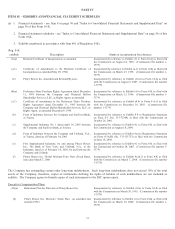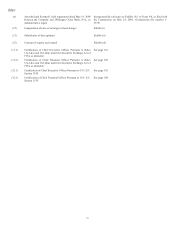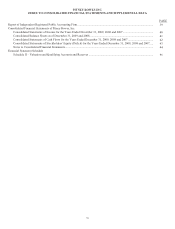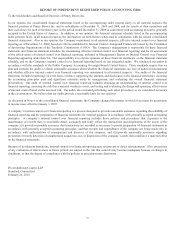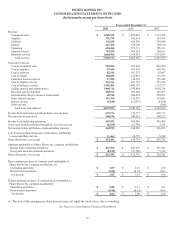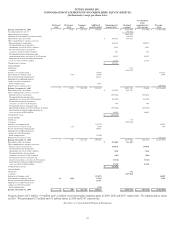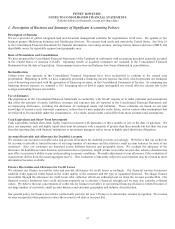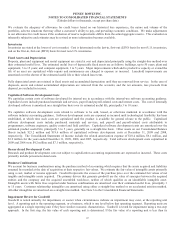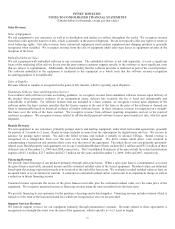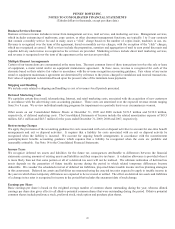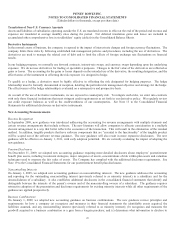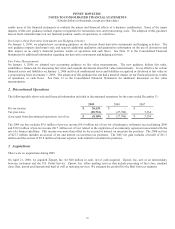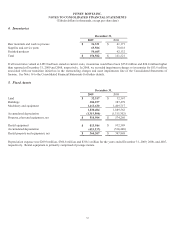Pitney Bowes 2009 Annual Report Download - page 62
Download and view the complete annual report
Please find page 62 of the 2009 Pitney Bowes annual report below. You can navigate through the pages in the report by either clicking on the pages listed below, or by using the keyword search tool below to find specific information within the annual report.PITNEY BOWES INC.
NOTES TO CONSOLIDATED FINANCIAL STATEMENTS
(Tabular dollars in thousands, except per share data)
44
1. Description of Business and Summary of Significant Accounting Policies
Description of Business
We are a provider of global, integrated mail and document management solutions for organizations of all sizes. We operate in two
business groups: Mailstream Solutions and Mailstream Services. We operate both inside and outside the United States. See Note 18
to the Consolidated Financial Statements for financial information concerning revenue, earnings before interest and taxes (EBIT) and
identifiable assets, by reportable segment and geographic area.
Basis of Presentation and Consolidation
We have prepared the Consolidated Financial Statements of the Company in conformity with accounting principles generally accepted
in the United States of America (GAAP). Operating results of acquired companies are included in the Consolidated Financial
Statements from the date of acquisition. Intercompany transactions and balances have been eliminated in consolidation.
Reclassification
Certain prior year amounts in the Consolidated Financial Statements have been reclassified to conform to the current year
presentation. Beginning in 2009, we have separately presented a financing interest expense line item, which represents our estimated
cost of borrowing associated with the generation of financing revenues, in the Consolidated Statements of Income. In computing our
financing interest expense, we assumed a 10:1 leveraging ratio of debt to equity and applied our overall effective interest rate to the
average outstanding finance receivables.
Use of Estimates
The preparation of the Consolidated Financial Statements in conformity with GAAP requires us to make estimates and assumptions
that affect the amounts of assets, liabilities, revenues and expenses that are reported in the Consolidated Financial Statements and
accompanying disclosures, including the disclosure of contingent assets and liabilities. These estimates are based on our best
knowledge of current events, historical experience, actions that we may undertake in the future, and on various other assumptions that
are believed to be reasonable under the circumstances. As a result, actual results could differ from those estimates and assumptions.
Cash Equivalents and Short-Term Investments
Cash equivalents include short-term, highly liquid investments with maturities of three months or less at the date of purchase. We
place our temporary cash and highly liquid short-term investments with a maturity of greater than three months but less than one year
from the reporting date with financial institutions or investment managers and/or invest in highly rated short-term obligations.
Accounts Receivable and Allowance for Doubtful Accounts
We estimate our accounts receivable risks and provide allowances for doubtful accounts accordingly. We believe that our credit risk
for accounts receivable is limited because of our large number of customers and the relatively small account balances for most of our
customers. Also, our customers are dispersed across different business and geographic areas. We evaluate the adequacy of the
allowance for doubtful accounts based on our historical loss experience, length of time receivables are past due, adverse situations that
may affect a customer’s ability to pay and prevailing economic conditions. We make adjustments to our allowance if the evaluation of
requirements differs from the actual aggregate reserve. This evaluation is inherently subjective and estimates may be revised as more
information becomes available.
Finance Receivables and Allowance for Credit Losses
We estimate our finance receivables risks and provide allowances for credit losses accordingly. Our financial services businesses
establish credit approval limits based on the credit quality of the customer and the type of equipment financed. We charge finance
receivables through the allowance for credit losses after collection efforts are exhausted and we deem the account uncollectible. Our
financial services businesses base credit decisions primarily on a customer’s financial strength and we may also consider collateral
values. We believe that our concentration of credit risk for finance receivables in our internal financing division is limited because of
our large number of customers, small account balances and customer geographic and industry diversification.
Our general policy for finance receivables contractually past due for over 120 days is to discontinue revenue recognition. We resume
revenue recognition when payments reduce the account to 60 days or less past due.


